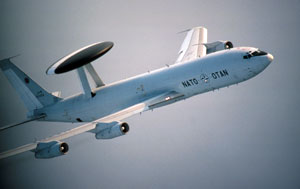NATO Airborne Early Warning and Control Programme Management Organisation (NAPMO)
The NAPMO is responsible for the management and implementation of the NATO Airborne Early Warning and Control (NAEW&C) programme – a fleet of special, ‘early warning’ aircraft.

The NAEW&C programme currently consists of 18 E-3A aircraft and three trainer aircraft. It provides the Alliance with an immediately available airborne surveillance, warning and command capability.
This capability has been used extensively in NATO operations, as well as to protect major public events in NATO member countries.
What are its authority, tasks, and responsibilities?
The NAPMO was established by a NATO Charter on 8 December 1978 as a NATO Production and Logistic Organisation. This gives it the status of a formal subsidiary organisation of NATO under the provisions of the 1951 Ottawa Agreement on the Status of NATO National Representatives and International Staff.
It is responsible for all aspects of the management, implementation and modernisation of the NAEW&C programme.
It reports directly to the North Atlantic Council, NATO’s principal decision-making body.
Who participates?
The NAPMO's members are the 15 countries that contribute to the AEW&C programme: Belgium, Canada, Denmark, Germany, Greece, Hungary, Italy, Luxembourg, the Netherlands, Norway, Poland, Portugal, Spain, Turkey, and the United States. The United Kingdom has its own fleet of E-3D AWACS aircraft which it provides to the NAPMO as a 'contribution in kind'.
Both the United States and France have their own national AWACS fleets. France attends NAPMO meetings as an observer, however its E-3F AWACS aircraft participate in joint operations with NATO counterparts on a case-by-case basis.
How does it work in practice?
NATO’s Airborne Early Warning and Control Programme Management Organisation consists of a Board of Directors, supported by a Programme Management Agency (NAPMA) which is located at Brunssum, the Netherlands; a Legal, Contracts and Finance Committee; an Operations, Technical and Support Committee; and, a Depot Level Maintenance Steering Group.
Each participating country is represented on the Board of Directors, which normally meets twice a year in formal session, and also in an optional special Spring meeting when required.
Representatives of the NATO Secretary General, the Alliance’s two Strategic Commanders, the NATO AEW&C Force Commander and other NATO bodies, if required, also attend meetings of the Board of Directors, Committees, and Steering Group, but have no voting rights. Decisions are taken on the basis of consensus among the participating countries.
The General Manager of the NAPMA is responsible for the day-to-day management of acquisition related activities in support of the NAEW&C Programme.
